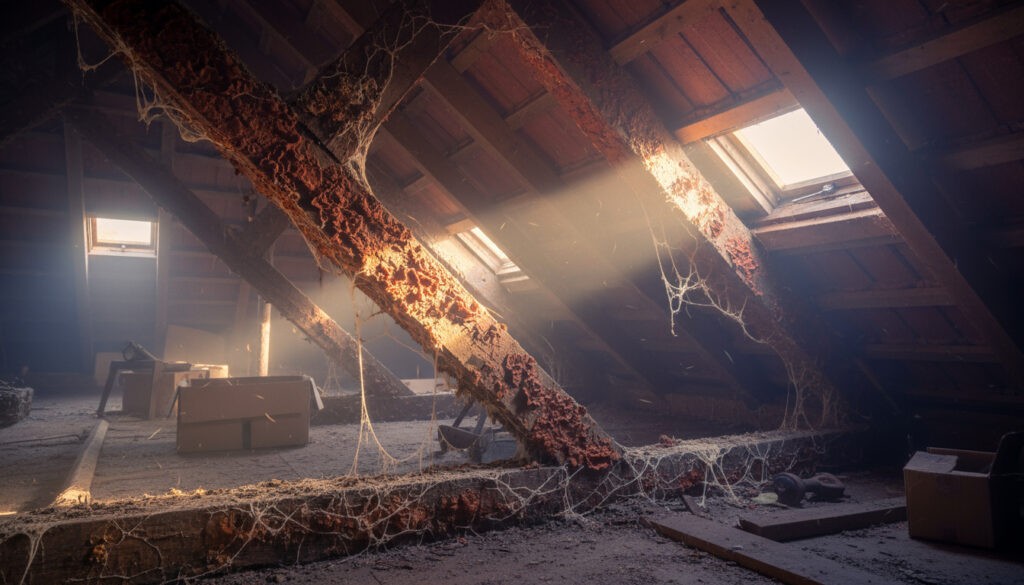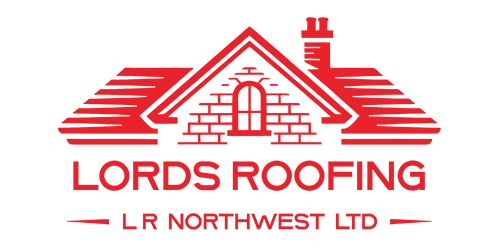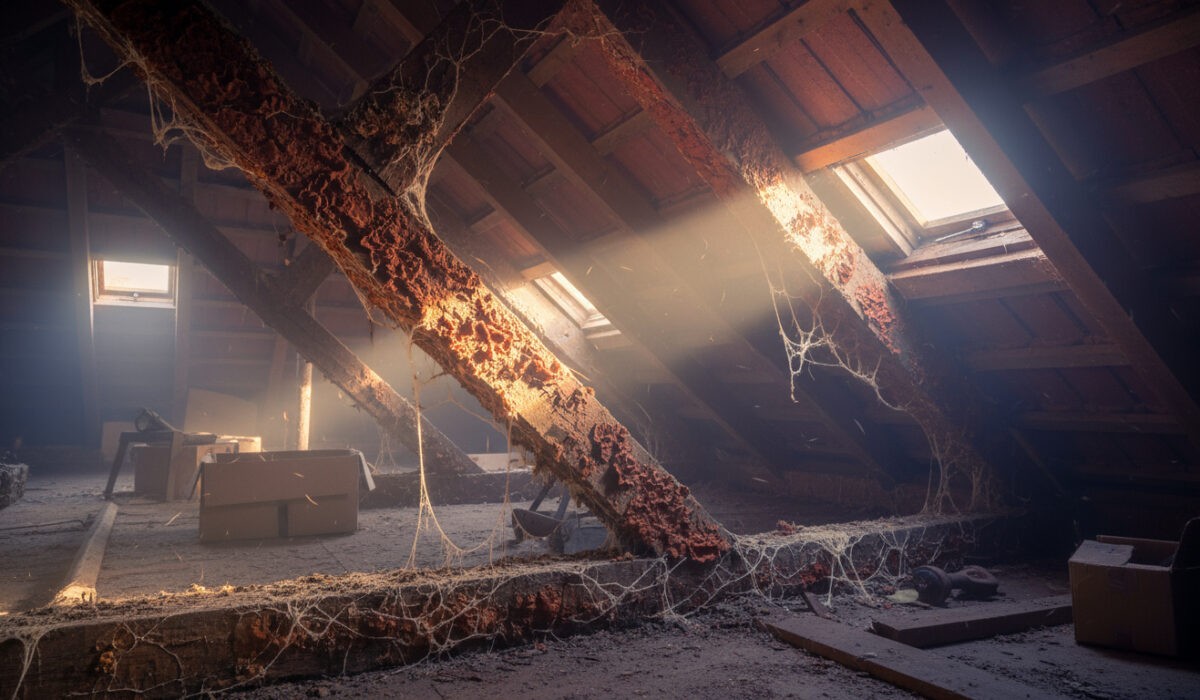Spotting the Silent Killers: A Guide to Woodworm and Dry Rot in Your Loft Timbers
The structure supporting your roof is often the most neglected part of your home. However, even a small, unaddressed roof leak can create the damp, humid conditions that invite two of the most destructive forces in property care: Woodworm and Dry Rot.
Left unchecked, these silent attackers can compromise the structural integrity of your loft joists and rafters, turning a simple roof repair into a costly structural replacement. Here’s what every UK homeowner needs to know to spot the early signs.
Part 1: How to Spot an Active Woodworm Infestation
Woodworm is the collective term for the larvae of wood-boring beetles, such as the common furniture beetle or the more destructive deathwatch beetle. The real damage is done by the larvae as they tunnel through the timber for several years before emerging as adult beetles.
| Sign | Description | Significance |
| Exit Holes | Small, round holes (typically 1–5mm in diameter) on the surface of the timber. | These indicate a beetle has successfully matured and left the wood. |
| Frass (Bore Dust) | A fine, powdery, sawdust-like dust found around the exit holes or in small piles on the floor/insulation below. | This is the key to activity. If the dust is pale, clean, and fresh, the infestation is active. |
| Crumbling Edges | Joists or rafters that feel soft or crumble easily when probed with a screwdriver. | This indicates extensive internal tunnelling, compromising the load-bearing capacity. |
| Adult Beetles | Live or dead brown beetles found near the loft window (they are attracted to light). | Beetles emerge mainly during the warmer “flight season” (May to September) to mate and lay new eggs. |
The Golden Rule: The presence of old holes only means woodworm was there. The presence of fresh frass means it is active right now.
Part 2: Identifying the Aggressive Danger of Dry Rot
Dry rot (Serpula lacrymans) is arguably the most destructive form of fungal decay. It is more serious than common wet rot because it can spread rapidly across non-timber materials, such as brick and masonry, in search of new timber to consume.
| Sign | Appearance/Symptom | Implication |
| The Smell | A strong, damp, mushroom-like, or musty odour permeating the loft or rooms below. | This is the distinctive smell of the actively growing fungus. |
| Cuboidal Cracking | The affected timber shrinks, darkens, and cracks into deep, cube-shaped pieces (often described as a ‘brown rot’). | The fungus has digested the wood’s strength-giving cellulose. |
| Mycelium Growth | White or grey, cotton wool-like strands or silky sheets spreading over the wood, walls, or plaster. | This is the fungal ‘root system’ that carries water and allows the rot to spread. |
| Fruiting Body | A flat, rusty-red or orange ‘pancake-like’ growth with a white outer edge. | This is the final stage, which releases millions of rusty-red spores into the air to start new infections. |
Dry rot thrives on timber with as little as 20% moisture content, which is easily achieved in a poorly ventilated loft with a small leak or persistent condensation.

Part 3: Why This is a Job for a Professional Roofer/Surveyor
For both woodworm and dry rot, a DIY approach to treatment is highly risky, particularly in structural timbers like those in your roof. If the core moisture source isn’t fixed, or if the fungal spread is missed, the problem will inevitably return and be significantly worse.
The Professional Treatment Process
-
Stop the Source: The first step is always to identify and remediate the source of moisture—whether that is a defective flashing, missing tile, blocked gutter, or poor ventilation causing condensation. No treatment will work until the water ingress is stopped.
-
Specialist Survey: A qualified timber specialist will accurately identify the species of pest/fungus and use moisture meters to map the full extent of the damage, which often hides behind plaster or insulation.
-
Remedial Treatment:
-
For Woodworm: The affected area is typically sprayed with a targeted insecticidal solution which penetrates the timber to kill the burrowing larvae and prevent future egg-laying.
-
For Dry Rot: All affected wood is removed and replaced with preservative-treated timber. Surrounding masonry is treated with a fungicidal biocide to ensure all fungal strands and spores are destroyed.
-
-
Structural Integrity: Severely damaged structural timbers will be spliced or replaced to restore the load-bearing capacity of your roof, ensuring your home remains safe and secure.
If you suspect any dark patches, musty smells, or powdery trails in your loft, do not delay. Contact Lords Roofing for a thorough inspection to protect your home from these destructive elements.


